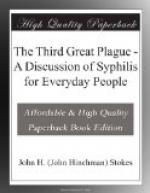+Mode of Entry of the Germ.+—The germ of the disease probably gains entrance to the body through a break or abrasion in the skin or the moist red mucous surfaces of the body, such as those which line the mouth and the genital tract. The break in the surface need not be visible as a chafe or scratch, but may be microscopic in size, so that the first sore seems to develop on what is, to all appearances, healthy surface. It should not be forgotten that this surface need not be confined to the genital organs, since syphilis may and often does begin at any part of the body where the germ finds favorable conditions for growth.
+Incubation or Quiescent Period.+—Almost all germ diseases have what is called a period of incubation, in which the germ, after it has gained entrance to the body, multiplies with varying rapidity until the conditions are such that the body begins to show signs of the injury which their presence is causing. The germ of syphilis is no exception to this rule. Its entry into the body is followed by a period in which there is no external sign of its presence to warn the infected person of what is coming. This period of quiescence between the moment of infection with syphilis and the appearance of the first signs of the disease in the form of the chancre may vary from a week to six weeks or even two months or more, with an average of about two or three weeks.
In the length of the incubation period and the comparatively trifling character of the early signs, the germ of syphilis betrays one of its most dangerous characteristics. The germ of pneumonia, for example, may be present on the surface of the body, in the mouth or elsewhere, for a long time, but the moment it gets a real foothold, there is an immediate and severe reaction, the body puts up a fight, and in ten days or so has either lost or won. The germ of syphilis, on the other hand, secures its place in the body without exciting very strenuous or wide-spread opposition. The body does not come to its own defense so well as with a more active enemy. The fitness of the germ of syphilis for long-continued life in the body, and the difficulty of marshaling a sufficient defense against it, is what makes it impossible to cure the disease by any short and easy method.




